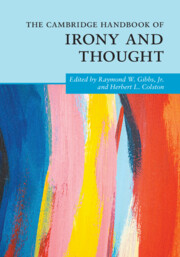Book contents
- The Cambridge Handbook of Irony and Thought
- Cambridge Handbooks in Psychology
- The Cambridge Handbook of Irony and Thought
- Copyright page
- Contents
- Contributors
- Part I Introduction
- Part II The Scope of Irony
- Part III Irony’s Impact
- Part IV Irony in Linguistic Communication
- 8 Constructions in Verbal Irony Production: The Case of Rhetorical Questions
- 9 Tracking the Ironical Eye: Eye Tracking Studies on Irony and Sarcasm
- 10 Inferring Irony Online
- 11 Irony and Thought: Developmental Insights
- 12 Vocal Strategies in Verbal Irony
- 13 Great Expectations and EPIC Fails: A Computational Perspective on Irony and Sarcasm
- Part V Irony, Affect, and Related Figures
- Part VI Irony in Expressive, Nonlinguistic Media
- Index
- References
8 - Constructions in Verbal Irony Production: The Case of Rhetorical Questions
from Part IV - Irony in Linguistic Communication
Published online by Cambridge University Press: 20 December 2023
- The Cambridge Handbook of Irony and Thought
- Cambridge Handbooks in Psychology
- The Cambridge Handbook of Irony and Thought
- Copyright page
- Contents
- Contributors
- Part I Introduction
- Part II The Scope of Irony
- Part III Irony’s Impact
- Part IV Irony in Linguistic Communication
- 8 Constructions in Verbal Irony Production: The Case of Rhetorical Questions
- 9 Tracking the Ironical Eye: Eye Tracking Studies on Irony and Sarcasm
- 10 Inferring Irony Online
- 11 Irony and Thought: Developmental Insights
- 12 Vocal Strategies in Verbal Irony
- 13 Great Expectations and EPIC Fails: A Computational Perspective on Irony and Sarcasm
- Part V Irony, Affect, and Related Figures
- Part VI Irony in Expressive, Nonlinguistic Media
- Index
- References
Summary
This chapter describes the contribution that grammatical constructions may have in detecting ironic intent in discourse. Constructions are very flexible devices that can be “manipulated” by speakers for specific communicative purposes, including instances where people “play” with or even “violate” the rules of grammar. Her specific focus on rhetorical questions (e.g., “How about another piece of pie?” said to someone who has already eaten more than his share of the pie) reveals how irony allows speakers to present alternatives that balance between accepting and rejecting a particular frame, or understanding of some situation. Rhetorical questions can both appear to accept some frame (e.g., the addressee is invited to have another piece of pie) and cancel or negate it (e.g., the addressee should not have another piece of pie given how much he has already eaten), which together often sets the stage for intense awareness of irony. Rhetorical questions (e.g., “How can I stand this stupid world without a mobile phone?”) also have diplomatic functions, because they allow people to express one socially accepted frame (e.g., mobile phones are necessary) while also challenging this belief through the evocation of irony (e.g., mobile phones are annoying, yet addictive).
- Type
- Chapter
- Information
- The Cambridge Handbook of Irony and Thought , pp. 131 - 139Publisher: Cambridge University PressPrint publication year: 2023



